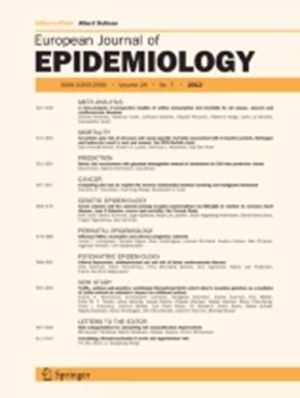基于人群的KORA-F3研究中自主神经功能的传统和先进心电图测量。
IF 5.9
1区 医学
Q1 PUBLIC, ENVIRONMENTAL & OCCUPATIONAL HEALTH
引用次数: 0
摘要
aimshear -rate变异性(HRV)测量是窦结水平自主神经功能的替代品,并已发展成为心肌梗死(MI)后患者心血管死亡率的标志物。传统的HRV评估是在时域和频域进行的。自主功能的高级测量包括减速能力(DC)和周期复极化动力学(PRD)。DC主要量化副交感神经张力的影响。PRD捕获复极不稳定的低频振荡,被认为反映了左心室心肌水平的交感神经活动。然而,缺乏基于人口的参考值。方法和结果在基于人群的KORA F3研究(奥格斯堡地区合作卫生研究)的505名参与者中,我们在时间和频率域评估了HRV标记物。此外,我们确定了自主功能的先进措施,包括DC和PRD应用先前建立的技术。我们使用标准的、预先定义的临界值来定义高危人群。该队列的平均年龄为63.6±5.5岁,女性256例(50.1%)。在HRV测量中,所有正态到正态区间(SDNN)的中位标准差为141 ms[119;165],低频与高频之比(LF/HF-ratio)中位为3.92[2.69;6.18]。自主神经功能方面,中位DC为5.32 ms[2.69;6.18],中位PRD为2.92 ms[2.06;4.14]。在这些指标中,男性的LF/ hf比值显著高于男性(5.15 [3.23;7.20])高于女性(3.37 [2.36;4.53],p < 0.001)。在没有明显心血管疾病的队列亚群中也提供了测量分布。DC随年龄增长而下降,而sdn、LF/ hf比和PRD在各年龄组间保持稳定。对于合并高血压、β受体阻滞剂摄入、心肌梗死、中风或糖尿病病史的参与者,观察到显著降低的SDNN、LF/ hf比和DC。结论:在一个以人群为基础的队列中,我们系统地介绍了心脏自主功能HRV的传统和先进测量方法。我们报告了整个队列的参考值,以及按性别、年龄和伴发心血管疾病分层。本文章由计算机程序翻译,如有差异,请以英文原文为准。
Traditional and advanced electrocardiographic measures of autonomic function in the population-based KORA-F3 study.
AIMS
Heart-rate variability (HRV) measures are surrogates of autonomic function at the level of the sinus node and have evolved as markers of cardiovascular mortality in patients after myocardial infarction (MI). Traditionally, HRV is assessed in time-domain and frequency domain. Advanced measures of autonomic function include deceleration capacity (DC) and periodic repolarization dynamics (PRD). DC predominantly quantifies the influence of parasympathetic tone. PRD captures low-frequency oscillations of repolarization instability and is considered to reflect sympathetic activity at the level of the left ventricular myocardium. However, population-based reference values are missing.
METHODS AND RESULTS
In 505 participants of the population-based KORA F3 study (Cooperative Health Research in the Region of Augsburg) with extant digital 24-h Holter electrocardiograms we assessed markers of HRV in time and frequency domains. Additionally, we determined advanced measures of autonomic function including DC and PRD applying previously established technologies. We used standard, pre-defined cut-off values to define high-risk groups. The cohort's mean age was 63.6 ± 5.5 years, and 256 (50.1%) were women. Among HRV measures, exemplarily the median standard deviation of all normal-to-normal intervals (SDNN) was 141 ms [119;165] and the median low frequency to high frequency ratio (LF/HF-ratio) was 3.92 [2.69;6.18]. Regarding autonomic function, median DC was 5.32 ms [2.69;6.18], and median PRD was 2.92 ms [2.06;4.14]. Among these measures LF/HF-ratio was significantly higher among men (5.15 [3.23; 7.20]) than women (3.37 [2.36;4.53], p < 0.001). Measured distribution is also provided in a cohort subset without overt cardiovascular conditions. While DC decreased with age, SDNN, LF/HF-ratio, and PRD were stable across age-groups. For participants with comorbidities including hypertension, intake of betablockers, history of MI, stroke, or diabetes mellitus significantly lower SDNN, LF/HF-ratio, and DC were observed.
CONCLUSION
In a large population-based cohort, we systematically present traditional and advanced measures of HRV of cardiac autonomic function. We report reference values in the overall cohort, as well as stratified by sex, age, and concomitant cardiovascular conditions.
求助全文
通过发布文献求助,成功后即可免费获取论文全文。
去求助
来源期刊

European Journal of Epidemiology
医学-公共卫生、环境卫生与职业卫生
CiteScore
21.40
自引率
1.50%
发文量
109
审稿时长
6-12 weeks
期刊介绍:
The European Journal of Epidemiology, established in 1985, is a peer-reviewed publication that provides a platform for discussions on epidemiology in its broadest sense. It covers various aspects of epidemiologic research and statistical methods. The journal facilitates communication between researchers, educators, and practitioners in epidemiology, including those in clinical and community medicine. Contributions from diverse fields such as public health, preventive medicine, clinical medicine, health economics, and computational biology and data science, in relation to health and disease, are encouraged. While accepting submissions from all over the world, the journal particularly emphasizes European topics relevant to epidemiology. The published articles consist of empirical research findings, developments in methodology, and opinion pieces.
 求助内容:
求助内容: 应助结果提醒方式:
应助结果提醒方式:


